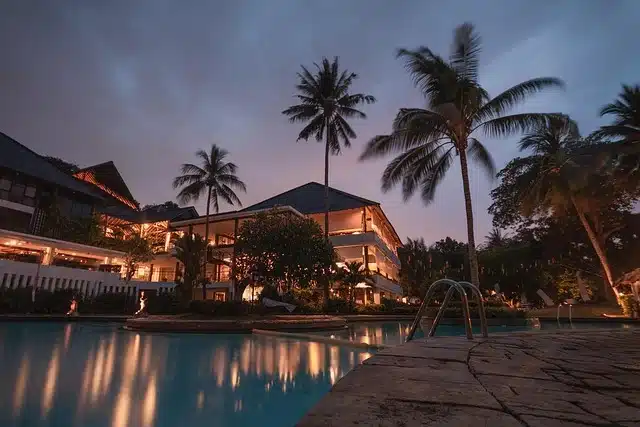Contents
ToggleThe State of Australia’s Hospitality Industry in 2025
The hospitality industry Australia is undergoing significant transformation as it moves toward 2030. With shifting traveller expectations, technological advancements, and as well as increasing competition. Hoteliers must stay ahead of these trends to remain profitable and as well as relevant.
Current Market Landscape
The hotel industry in Australia has rebounded strongly from the pandemic, with tourism numbers climbing back to pre-2020 levels.
According to recent statistics:
- Market Growth: As of 2021, there were approximately 6,000 hotels and similar establishments across the country, a number that is steadily growing.
- Revenue Growth: The industry’s annual revenue is projected to reach approximately USD 37.45 billion by 2030, fueled by both domestic and international travel.
- International Arrivals: Australia will welcome 11 million international visitors annually by 2027, increasing demand for hotels, resorts, and apartments.
- Occupancy Rates: Hotel occupancy rates have rebounded to above 70% in major cities, including Sydney, Melbourne, and Brisbane, with some regional markets experiencing even higher demand.
This growth is driven by several key factors, including increased domestic travel, a resurgence in international tourism, and rising demand for luxury and boutique accommodations.
Additionally, major global events such as the 2032 Brisbane Olympics are already spurring new hotel developments, particularly in Queensland.
Cities are experiencing a wave of investments in both new builds and refurbishments to cater to the evolving traveler demographic.
However, despite these promising figures, hoteliers must navigate major challenges, including:
- Labor shortages: The hospitality industry continues to struggle with a shortage of skilled workers, increasing labor costs and as well as operational inefficiencies.
- Rising operational costs: Inflation is driving up expenses related to utilities, supplies, and wages, squeezing profit margins.
- Changing guest expectations: Modern travelers demand more personalized, technology-driven experiences and as well as sustainable business practices.
To maintain profitability and deliver superior guest experiences, hotels must invest in innovative technology, guest experience enhancements, and sustainability initiatives.
Key Trends Shaping The Hospitality Industry In Australia by 2030
1. The Rise of Smart Hotels
Technology is rapidly transforming the guest experience and back-end operations in the hospitality sector. By 2030, smart hotels will be the industry standard, integrating AI, automation, and IoT (Internet of Things) to enhance both convenience and efficiency. Some of the most significant innovations include:
- Contactless Check-in & Check-out: Mobile apps and facial recognition technology are replacing traditional front desk interactions, reducing wait times and enhancing security.
- AI-powered Personalization: Hotels are leveraging guest data to tailor experiences, from customized room settings to personalized recommendations for dining and activities.
- Smart Room Controls: Guests can control lighting, temperature, and entertainment through voice commands or mobile apps, creating a seamless and comfortable stay.
- Chatbots and Virtual Concierges: AI-powered chatbots assist guests with requests, bookings, and as well as inquiries, improving customer service efficiency.
- Automated Housekeeping and Maintenance: Hotels are investing in robotics and as well as AI-driven maintenance systems that can predict repairs and optimize cleaning schedules.
Investing in a cloud-based hotel PMS will be crucial for hoteliers looking to implement these changes efficiently.
Also, for more information about the impact of AI in hospitality, read: The Impact of AI on the Hospitality Industry.
2. Sustainability as a Core Business Strategy
With travelers becoming more environmentally conscious, sustainability is no longer optional. Hotels that fail to adopt eco-friendly practices risk losing customers to competitors who prioritize green initiatives. By 2030, sustainability will be a key differentiator in the Australian hotel industry, with properties focusing on:
- Energy-efficient infrastructure: Many hotels are investing in solar panels, smart thermostats, and LED lighting to reduce energy consumption.
- Water conservation: Hotels are implementing water-saving technologies such as low-flow fixtures, rainwater harvesting, and smart irrigation systems.
- Waste reduction programs: Many properties are phasing out single-use plastics, introducing composting initiatives, and increasing recycling efforts.
- Carbon neutrality goals: Major hotel chains are committing to net-zero carbon emissions by 2030, setting new sustainability benchmarks for the industry.
- Green certifications: More hotels are obtaining Green Star ratings, EarthCheck certifications, and LEED accreditations to showcase their environmental commitment.
- Eco-friendly guest experiences: Travelers are seeking organic, locally sourced food options, sustainable toiletries, and eco-conscious transportation options, driving hotels to adapt their offerings.
Hotels that embrace sustainable practices will reduce their environmental footprint while also attract eco-conscious travelers who are willing to pay a premium for green accommodations.
If you want to learn more about eco-friendly practices, check out The Future of Sustainable Hospitality or Sustainability Practices for Eco-Friendly Hotel Management.
3. The Evolution of the Luxury and Boutique Travel Market
As the Australian hotel industry grows, so does the demand for unique, high-end experiences. The definition of luxury shifts from opulence to authenticity, personalization, and sustainability. Key developments in this sector include:
- Experiential luxury: Guests are looking for unique, immersive experiences such as private cultural tours, adventure tourism, and wellness retreats.
- Boutique hotels on the rise: Travelers are favoring smaller, independent boutique hotels over large chains, drawn to their local charm and customized service.
- Wellness tourism growth: Hotels are investing in spa facilities, fitness programs, and mental wellness experiences to cater to the health-conscious traveler.
- Sustainable luxury: High-end travelers are prioritizing eco-conscious accommodations with organic amenities, farm-to-table dining, and carbon-offset initiatives.
The future of luxury hospitality lies in combining technology, sustainability, and deeply personalized service, ensuring guests receive memorable and exclusive experiences.
For more insights on market segmentation and tailoring your services to specific customer profiles, read: A Comprehensive Guide to Hotel Market Segmentation.
4. Overcoming Labor Shortages and Workforce Challenges
One of the most pressing issues for the Australian hospitality industry is the ongoing labor shortage. With fewer skilled workers entering the industry, hotels are struggling to maintain service standards and operational efficiency. By 2030, hoteliers will need to adopt new strategies to attract, retain, and develop talent. Solutions include:
- AI and automation: Reducing dependency on manual labor with technology that automates check-ins, housekeeping, and guest services, like an hotel PMS.
- Upskilling and training programs: Investing in employee development to build a more skilled and adaptable workforce.
- Flexible work arrangements: Offering hybrid and part-time roles to appeal to a broader talent pool.
- Improved compensation and benefits: Competitive salaries, career advancement opportunities, and work-life balance initiatives to retain employees.
- Government partnerships: Collaborating with educational institutions and government agencies to create hospitality training programs and attract new talent.
Hotels that proactively address labor challenges will be better positioned to maintain high service levels and profitability in the coming years.
For more information about hotel operations and workforce challenges, read our blog: Everything You Need to Know About Hotel Operations Management
5. The Role of Artificial Intelligence and Big Data in Revenue Management
As the Australian hotel industry moves toward 2030, data-driven decision-making will become a necessity for maintaining profitability in an increasingly competitive market. Revenue managers will rely heavily on artificial intelligence (AI) and big data analytics to optimize pricing, forecast demand, and enhance guest personalization.
Key Advancements in AI and Big Data for Hotels:
- Dynamic Pricing Strategies: A hotel revenue management tool analyzes real-time market trends, competitor rates, and booking patterns to automatically adjust pricing and as well as maximize occupancy.
- Predictive Demand Forecasting: Advanced analytics help hotels anticipate seasonal fluctuations, local event-driven demand, and even economic impacts to improve inventory management.
- Guest Personalization: AI can tailor promotions, recommend services, and even customize room settings based on past guest preferences, leading to increased customer satisfaction and also loyalty.
- Operational Efficiency: Machine learning algorithms can optimize staff scheduling, reduce food waste in restaurants, and as well as even predict maintenance issues before they arise.
Hotels investing in revenue management solutions will gain a significant edge, ensuring higher profitability and better guest experiences. Solutions like roomMaster’s revenue management software help hoteliers stay ahead of market fluctuations and as well as automate pricing strategies.
To understand how dynamic pricing and data analytics can boost revenue, consider reading our blog about: Dynamic Pricing in Hospitality Industry.
6. The Evolution of Direct Bookings, Workforce Strategies, and Diversification
Hospitality in Australia is adapting to technological and sustainability trends and reshaping its distribution channels, workforce management, and business models.
These shifts will define the sector’s competitiveness and as well as profitability in the coming years.
Direct Bookings on the Rise
The pandemic reshaped guest expectations and booking behaviors, leading to a significant decline in consumer trust in Online Travel Agencies (OTAs). Travelers experienced difficulties with cancellations, refunds, and as well as lack of customer support, driving them toward direct bookings with hotels.
By 2030, direct bookings are projected to become the dominant reservation channel, reducing dependency on third-party platforms. To capitalize on this shift, hotels are:
- Investing in branded hotel booking engines that offer seamless, commission-free reservations directly on their websites.
- Enhancing loyalty programs with exclusive discounts, rewards, and as well as perks for returning guests.
- Improving website user experience (UX) with faster load times, optimized mobile navigation, and as well as AI-powered chatbots to assist guests in real-time.
- Leveraging metasearch and digital marketing to increase visibility and attract direct traffic.
Hotels with a good hotel booking engine will increase profit margins by reducing OTA commissions and will gain greater control over guest relationships.
For tips on driving direct bookings and reducing OTA dependency, see How to Increase Direct Bookings for Hotels.
The Growth of Cultural Tourism
Expedia’s travel trends indicate a growing interest in cultural tourism, with travellers seeking immersive experiences in history, arts, and local traditions.
Sydney ranks among the world’s top cultural destinations. This is signalling strong demand for heritage-driven travel experiences.
Hotels can leverage this trend by:
- Collaborating with local artists, museums, and as well as cultural institutions to offer guests exclusive experiences.
- Creating themed packages that include guided city tours, culinary experiences, and as well as indigenous cultural activities.
- Integrating storytelling into branding, positioning properties as gateways to local culture and history.
Hotels that successfully align with cultural tourism trends will attract high-value travelers looking for meaningful and immersive experiences.
8. Business Diversification: Beyond Accommodation
The traditional hotel model is evolving as hotels diversify their revenue streams, tapping into new markets beyond lodging. By 2030, many properties will operate as multi-functional spaces, incorporating:
- Coworking spaces and remote work hubs to attract digital nomads and as well as business travelers.
- Hotel-branded residences that offer long-term leasing options for extended stays.
- On-site wellness centers open to both guests and the public, featuring spa treatments, fitness classes, and as well as holistic health programs.
- Event and meeting space rentals for corporate and social gatherings.
Furthermore, this diversification allows hotels to increase revenue resilience. Especially in a market that fluctuates due to seasonality and as well as economic downturns.
For more on diversifying revenue streams and innovative business models in hospitality, check out: Benefits of Yield Management in the Hotel Industry.
Key Takeaways: Australia’s Hospitality Industry – Into 2030 and Beyond
Smart Hotels Lead the Tech Revolution
- AI, IoT, and automation will dominate operations, enabling contactless check-ins, smart room controls, and AI-driven customization. Cloud-based hotel PMS solutions like roomMaster are critical for seamless integration.
Sustainability as a Non-Negotiable Strategy
- Eco-friendly practices (solar energy, zero-waste programs, carbon neutrality). Furthermore, certifications (EarthCheck, Green Star) will attract eco-conscious travelers and as well as command premium pricing.
Luxury Redefined: Boutique & Experiential Travel
- High-end travelers prioritize authenticity, wellness retreats, and as well as sustainable luxury (organic dining, carbon offsets). This favors boutique hotels over traditional chains.
Tackling Labor Shortages with Innovation
- Automation, upskilling programs, and flexible work models will address workforce gaps while maintaining service quality.
AI and Big Data Drive Revenue Optimization
- Dynamic pricing, predictive analytics, and AI-powered personalization will maximize occupancy and guest loyalty through data-driven strategies.
Direct Bookings Dominate Distribution Channels
- Hotels are investing in branded hotel booking engines, loyalty programs, and as well as UX improvements to reduce OTA reliance and retain guest relationships.
Cultural Tourism as a Growth Catalyst
- Partnerships with local artists, Indigenous communities, and cultural institutions offer immersive experiences, positioning hotels as cultural hubs.
Diversification Beyond Traditional Accommodation
Hotels expand into coworking spaces, branded residences, wellness centers, and as well as event venues to boost resilience against market fluctuations.
FAQs: Hospitality Industry in Australia– Into 2030 and Beyond
What factors are driving growth in the Australian hotel market?
A: Growth is fueled by a post-pandemic tourism rebound, an expected 11 million international arrivals by 2027. Moreover, significant investments in new developments, and major events like the Brisbane Olympics boosting regional demand.
Q: How is technology reshaping the hospitality landscape in Australia?
A: Australian hotels are increasingly leveraging AI, IoT, and cloud-based PMS solutions . This is to provide contactless check-ins, personalized guest experiences, and streamlined operations.
Q: What sustainability initiatives are Australian hotels implementing?
A: Many properties are investing in energy-efficient systems, such as solar panels and LED lighting, water conservation, waste reduction programs. Moreover, pursuing certifications like Green Star and EarthCheck to meet the demands of eco-conscious travelers.
Q: How are hotels in Australia addressing labor shortages?
A: Hotels are mitigating workforce challenges through comprehensive upskilling programs, flexible work arrangements, as well as improved compensation. Furthermore, also increase automation to maintain high service levels.

Mayela Lozano is a content strategist with a passion for hospitality and technology. She collaborates with InnQuest on content creation, highlighting how technology can streamline hotel operations and enhance guest satisfaction. When she’s not creating content, Mayela loves to travel and spend time with her two little ones, discovering new adventures and making memories along the way.









